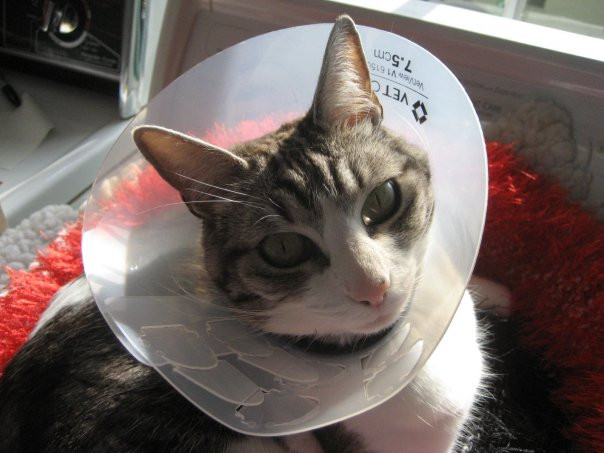Elizabethan collars, often humorously called “cones of shame,” are lampshade-like devices frequently recommended by veterinarians. These collars are designed to prevent our feline friends (and dogs too!) from licking wounds, scratching stitches, or aggravating skin irritations, ultimately aiding in their recovery.
While the term “cone of shame,” possibly popularized by the movie “Up,” suggests a punitive aspect, the reality is more nuanced. Pet owners often feel conflicted about using E-collars, sometimes removing them prematurely, despite veterinary advice. Concerns about the pet’s comfort and well-being are valid, especially considering reports of accidents, like pets getting tangled in plastic bags while wearing cones.
A recent study published in Animals journal delved into the welfare implications of E-collar use in cats and dogs. The open-access research, titled “’The Cone of Shame’: Welfare Implications of Elizabethan Collar Use on Dogs and Cats as Reported by their Owners,” surveyed 434 pet owners who had used E-collars on their pets within the past year. The survey explored reasons for collar use, duration of wear, and observed issues or stress signs in pets. Most pets in the study wore the collar for 3 to 7 days.
The study revealed that over half of pet owners had welfare concerns related to cone usage. A significant 60.2% reported difficulties with drinking, and 67.5% noted their pet couldn’t play while collared. Furthermore, a quarter of pets sustained minor injuries, such as itching or bumping into objects, due to the collar. While almost a quarter of pets managed to remove the cone themselves, many owners admitted to removing it during supervised periods.
Most owners felt their pet’s quality of life decreased with the cone. They described their pets as “depressed,” experiencing eating difficulties, and exhibiting distress that seemed worse than the behavior the cone was meant to prevent. Fit issues were also noted, with some animals struggling to jump or walk normally.
However, the study also confirmed the effectiveness of Cat Cone Collars in preventing unwanted behaviors like licking and biting. While habituation to the collar might be possible with training, the immediate need for a cone often arises post-surgery or injury, leaving little time for gradual introduction.
Personal experiences echo these findings. One cat owner recounted a vet visit for their limping cat, diagnosed with a soft tissue injury. Despite the minor nature of the issue, a cone was prescribed. The cat’s distress led to early removal of the cone, with no adverse effects on recovery.
This raises critical questions: Is the cat cone collar a necessary evil? Is it always necessary? Are there better alternatives? To gain expert insight, we consulted Ellen Carozza, LVT, a feline medicine specialist at Nova Cat Clinic. With decades of experience, Ellen offers a progressive perspective on E-collar use.
***************
Q: Why did Nova Cat Clinic move away from routine E-collar use?
EC: We observed that E-collars often caused more stress than benefit. With effective multimodal pain management, we found that pets are significantly less likely to bother surgical sites. We also minimize external sutures, opting for internal and subcutaneous or subcuticular closures to reduce temptation to pick.
Client feedback highlighted issues like cats refusing to eat, bumping into walls, becoming withdrawn, and excessively grooming the collar itself – a sign of pain or discomfort they can’t directly address. The rigid cone can also disrupt sleep by forcing unnatural head and neck positions, hindering the healing process where rest is crucial.
Our approach prioritizes preemptive pain control using local blocks, opiates, Gabapentin, and NSAIDs (when kidney function allows). Complementary therapies like laser therapy and Assisi Loop further support healing by minimizing acute and chronic pain, keeping the pet comfortable throughout recovery.
Q: Why do many veterinary clinics still routinely use “cone of shame” collars?
EC: Many believe in their necessity, focusing on behavior cessation rather than addressing the underlying pain. There’s also a reliance on tradition – “we’ve always done it” mentality.
Furthermore, some believe it simplifies owner compliance. Ensuring a clean, dry incision site requires diligent pet owner attention, something not all owners consistently manage. E-collars are seen as a way to bypass this reliance on owner diligence.
Q: What are effective alternatives to cat cone collars, and is it time to rethink this practice?
EC: Numerous alternatives exist. Softer “cloud” or “balloon” collars offer improved eating access but can still impede comfortable rest. “No Bite” collars restrict neck movement, preventing normal flexibility. Some companies market “cute” E-collars shaped like flowers or lion manes, attempting to soften the “shameful” image – clever marketing, but not a solution to the core issue.
The most impactful alternative is proper pain management. Addressing underlying behavioral issues with medication and environmental adjustments is also crucial, especially for cats with obsessive grooming habits where no medical cause is found.
Yes, it’s time to move beyond routine “cone of shame” use. Advanced pain management protocols, behavioral understanding, and tailored environmental modifications should be prioritized to minimize reliance on E-collars. Utilizing feline pain scoring systems allows for proactive pain management, reducing the need to reactively resort to a cone.
******************
This research and expert insight highlight the need to reconsider routine E-collar use. Prioritizing pet welfare means exploring alternatives and focusing on comprehensive pain management. While effective at preventing licking and biting, the cat cone collar is not without its drawbacks. Open communication with your veterinarian about pain management strategies and alternative options is crucial for ensuring your cat’s comfortable and stress-free recovery.
 Cat wearing a cone collar looking out a window
Cat wearing a cone collar looking out a window
References
- Shenoda, Y., Ward, M. P., McKeegan, D., & Fawcett, A. (2020). “The Cone of Shame”: Welfare Implications of Elizabethan Collar Use on Dogs and Cats as Reported by their Owners. Animals, 10(2), 333.
- Shumaker, A. K. (2019). Diagnosis and treatment of canine acral lick dermatitis. Veterinary Clinics: Small Animal Practice, 49(1), 105-123.
- Wilson, S. (1993). Elizabethan collars and plastic bags. The Veterinary record, 132(26), 664-664.
